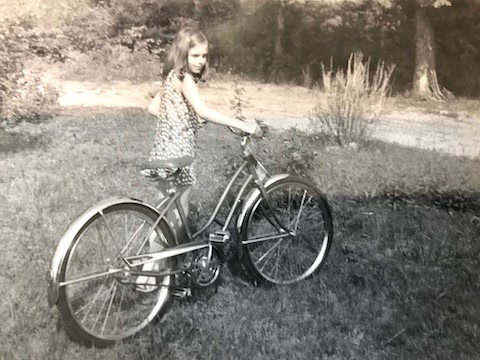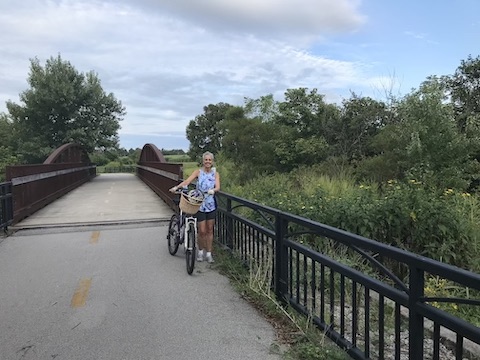A live, attenuated virus vaccine for Rubella, better known as the three-day or German measles, was discovered in 1969. It made its way to my hometown sometime during the 1970-71 school year when I was in fifth grade. I remember lining up in the school hallway to get inoculated after which I promptly developed mild symptoms of the disease. The younger sister of one of my closest friends also came down with a slight case. We were both prohibited from attending school for a week.
Since both of my parents were employed at the time, I spent the days in quarantine at my friend’s house with her mother and sister. Now Betty was more than just a family friend. She was like another parent to me and treated me like one of her own. Betty, her husband Fay, and their five children feature prominently in many of my happiest childhood memories, including this one.
After three days of being stuck indoors, the two of us isolates were becoming bored and restless. Since we were symptom free and the weather was warm, Betty suggested we go outside and ride bikes in the driveway. Well, believe it or not, I had never been on a bicycle. That’s right. Ten years old and no bike-riding experience. You might wonder how that is possible. Well, neither of my parents had ever owned a bicycle and frankly, my mother considered them unladylike and dangerous. So there you go.
Determined to remedy the situation, Betty took it upon herself to teach me how to ride. By that afternoon, I was zipping around their carport and driveway, wholly jubilant with my accomplishment. When my parents arrived to pick me up, even Mom’s lack of enthusiasm wasn’t enough to dampen my exuberance. Dad’s look of silent approval was all that was necessary to steel my resolve to keep riding.

Despite Mom’s misgivings, there was a shiny, new, blue ten-speed in my future. For the next few years, I spent hours cycling up and down our steep, quarter-mile long, gravel driveway, flushed from exertion, with matching scabby knees and scraped elbows, looking very unladylike indeed, much to her chagrin. Mom simply couldn’t imagine wanting to do anything that resulted in getting all sweaty. Never having ridden a bicycle, she failed to appreciate the feeling of triumph from pedaling to the top of our forty-five degree grade driveway only to turn around and sail back down, free as the wind. It felt sensational!
Several years ago, during summer vacation, my younger son asked if I would push his bike so he could walk along the shoreline in search of seashells. Just for fun, I hopped on and took off down the beach. I hadn’t been on a bicycle in over twenty years. Fortunately the old adage “…it’s just like riding a bike” held true. Indeed, I remembered how to ride, but I’d forgotten the exhilaration of pumping the pedals, getting into a rhythm, body and machine working synchronously. Nostalgia returned me to that first day on a bike. I’m convinced that if Betty hadn’t had the foresight to teach me how to ride, I’d still be on a tricycle, albeit an adult-sized one. A text message telling her as much elicited a “tears of laughter” emoji along with a loving note in reply.

Having rediscovered how invigorating riding a bicycle could be, my resolve to add this form of physical activity to my exercise regimen was in earnest. Upon returning home, I purchased a bike, outfitted it with a cushioned seat, donned a floral helmet, and set off. Uneasy about maneuvering in traffic, I opted for laps around the neighborhood park. The next several days found me incrementally increasing both distance and resistance to a level I could maintain for the time allotted to ride. It felt fantastic!
Neighbors started calling out the number of laps as I went past. After a few weeks, they started asking, “What are you training for?” Taken aback by the assumption I was training for an event or competition, I simply smiled and answered, “Old age,” which got a lot of laughs. After my older son got married, the revised response of, “Grandparenthood,” garnered more laughter. But eventually, having considered the benefits of adopting an active lifestyle at an early age, my cheerfully delivered, routine reply became, “I’m training for life.”
Reactions to that statement were completely unexpected. People flagged me down to ask what I meant. Eager to be neighborly, I stopped long enough to explain. My body is designed to move. In order for it to perform optimally, it needs to be exercised, so I take it out and exercise it every day. Varying the activity assures that none of the muscle groups are ignored. In order to improve efficiency and prevent blockages that could clog its systems, I’m selective in the food used to fuel my body. Furthermore, I strive to maintain a weight that it does not find taxing and make sure it gets enough rest. In order to do all the things I want to do with my husband, kids, and eventually, with any luck, grandkids, my body has to be healthy. Keeping it healthy is my responsibility. Being physically active is a major contributor to good health, so I keep moving. That’s what I mean by, “I’m training for life.”
This explanation has resulted in some lengthy, fascinating sidewalk conversations. Oftentimes, people will begin by making excuses for why they are not physically active. They don’t have a bike. They don’t have the right shoes. They can’t afford to take the time. They don’t feel like it.
They’re surprised when I counter their excuses with…you don’t have to bike, you could walk. You don’t have to have special shoes, they just need to be comfortable. You can’t afford not to make time to take care of your body. There are all kinds of ways to add physical activity into your day, no matter what your schedule. And doing anything is better than doing nothing. There are lots of times I don’t feel like walking, working out, or biking, but I do it anyway. Over the years, I’ve discovered that, ultimately, doing it feels so much better than not doing it.
Generally speaking, the hardest, but most important step is that first one. Getting started is all it takes. Here are some tips that have helped me successfully maintain an active lifestyle.
- Get Ready. Evaluate your current fitness level. If necessary, get a physical to determine your readiness.
- Adopt an Activity. The possibilities are endless. Jump, hop, bounce, march, dance, sway, swim, climb, walk, run, skip, push, pull, pedal, lift, play…JUST MOVE! Choose an activity that you are most likely to stick with and make it a part of your daily routine.
- Find a Partner. Becoming physically active can be a challenge, but having an ally can be mutually beneficial. Knowing there is someone waiting to join you, either in person or virtually, provides a potent incentive.
- Build a Support System. Whether it is staying on a diet, following through with medical treatment, or sticking with exercise, encouragement from a support system is critical. Invite the most important people in your life to champion your efforts. The approval and affirmation of a spouse, kids, parents, and friends is powerfully motivating.
- Start Slow and Easy. Every January I see newbies out running…red faced, breathing hard, struggling with every step. Before the end of the month, they are nowhere to be seen. Set realistic goals and ease into the new routine.
- Think of Food as Fuel. A college friend, who happened to be a soccer goalie, ate macaroni and cheese nearly every day. When I implied eating the same thing must get boring, he told me, “I eat to live. I don’t live to eat.” While I had no intention of adopting his dietary habits, his statement definitely gave me pause and led me to reexamine my attitude toward food. Instituting a practical approach to eating is empowering.
- Focus on Health Benefits. Increased energy, heightened sense of well being, improved brain functioning, and reduced stress are all associated with physical activity. These benefits aren’t measured on a scale or reflected in a mirror. Shift the focus away from how your body looks to how your body works.
- Normalize Exercise. Just a couple of generations ago, exercise was not something people even considered. Their daily lives required so much physical activity, recommending the need for exercise would have seemed absurd. But now, we have established conditions that make it possible to spend practically the entire day in a sitting position. Inactivity is as corrosive to the human body as plaque is to the teeth. Make physical activity as routine as brushing your teeth.
Spending a day without running, climbing, swinging, wandering, or of course, eventually biking would have been inconceivable to me as a kid. The need to move was as basic as food and water. At 60, it feels like I’ve cheated myself out of making the most of the day if I forgo a long walk, bike ride, or workout. The urge to move is as intense now as it was when I was younger. Certainly the pleasure derived from it is equally satisfying. The motivation may be slightly different. More than ever, I’m aware that if I fail to use it, I may lose it.
Getting older is something I’ve been doing since the day I was born. It didn’t just start happening. My ambition is to become my best self at every age, modeling for my kids how to grow old with vigor and grace. So, as part of my commitment to training for life, I just keep moving!

